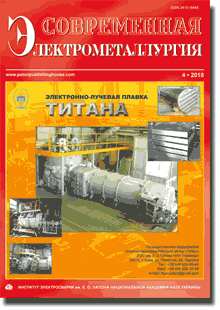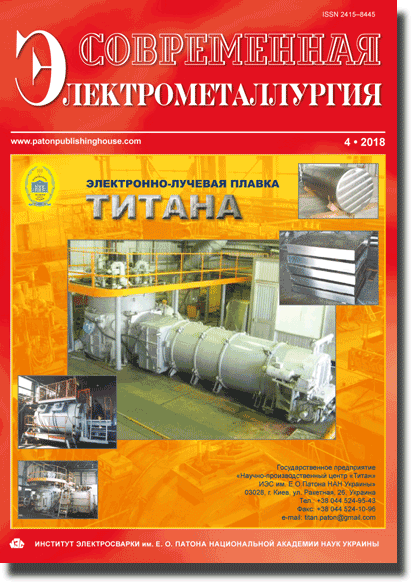| 2018 №04 (02) |
DOI of Article 10.15407/sem2018.04.03 |
2018 №04 (04) |

Electrometallurgy Today (Sovremennaya Elektrometallurgiya), 2018, #4, 42-51 pages
Structure of large profiled single crystals of tungsten, produced by additive plasma-induction surfacing
B. E. Paton, G. M. Grigorenko, L. I. Markashova, V. A. Shapovalov, E. N. Berdnikova, E. V. Polovetsky, V. V., Yakusha, A.N. Gnizdylo
E.O. Paton Electric Welding Institute of the NAS of Ukraine. 11 Kazimir Malevich Str., 03150, Kyiv, Ukraine. E-mail: office@paton.kiev.ua
Studied was the structure of large tungsten billet, produced by the method of additive plasma-induction layer-by-layer growing on monocrystalline primer at different speeds of the process (17…70 mm/min) The investigations ( of microhardness, sizes of subgrained structure, angles of subgraines disorientation, nature of distribution of dislocations, etc.) were carried out at all the structural levels by using a complex of experimental methods of modern physical materials science, including light, scanning and transmission microdiffraction electron microscopy. It is shown that the ingot represents a monocrystalline body with a crystallographic orientation, preset by the priming crystal, The increase in rate of growing up to 70 mm/min leads to a negligible decrease in microhardness, refining of structure at the uniform distribution of density of dislocations that allows producing tungsten single crystals with a perfect monocrystalline structure (with low-angle boundaries) at angles of disorientation, not exceeding 3о. Ref. 12, Tabl. 3, Fig. 7.
Key words: tungsten; plasma-induction growing; single-crystal ingot; structure; disorientation of subgrains; density of dislocations
Received: 30.08.18
Published: 15.11.18
References
1. Shapovalov, V.A., Kovalenko, A.A., Latash, Yu.V. et al. (1993) Investigation of growing process of tungsten and molybdenum single crystals. Problemy Spets. Elektrometallurgii, 1, 79–82 [in Russian].
2. Shapovalov, V.A., Yakusha, V.V., Gnizdylo, A.N., Nikitenko, Yu.A. (2016) Application of additive technologies for growing large profiled single crystals of tungsten and molybdenum. The Paton Welding J., 5–6, 134–136. https://doi.org/10.15407/tpwj2016.06.23
3. Shapovalov, V., Yakusha, V., Manulyk, A. (2015) Large refractory metals single crystals grown by plasma-induction zone melting. In: Proc. of 24th Int. Materials Research Congress 2015 (Cancun, Mexico, August 16-20, 2015). Sociedad Mexicana de Materiales A.C. S6B-O007. http//mrs-mexico.Org.mx/imrc2015
4. Paton, B.E., Shapovalov, V.A., Grigorenko, G.M. et al. (2016) Plasma-induction growing of profiled single crystals of refractory metals. Kiev, Naukova Dumka [in Russian].
5. Darovsky, Yu.F., Markashova, L.I., Abramov, N.P. et al. (1985) Preparation method for electron microscopic examinations. Avtomaticheskaya Svarka, 12, 60 [in Russian].
6. Tomas, G. (1963) Electron microscopy of metals. Moscow, Inostrannaya Literatura [in Russian].
7. Utevsky, L.M. (1973) Diffraction electron microscopy in physical metallurgy. Moscow, Metallurgiya [in Russian].
8. Hirsh, P., Khovi, A., Nikolson, R. et al. (1968) Electron microscopy of thin crystals. Moscow, Mir [in Russian].
9. Lyakishev, N.P., Burkhanov, G.S. (2002) Metallic single crystals. Moscow, ELIZ [in Russian].
10. Stroh, A.N. (1954) The formation of cracks as a recoil plastic flow. Proc. of the Roy. Soc. A, 223(1154), 404–415. https://doi.org/10.1098/rspa.1954.0124
11. Panin, V.E., Likhachev, V.A., Grinyaeva, Yu.V. (1985) Structural levels of deformation of solid bodies. Sibirskoe Otdelenie, Nauka [in Russian].
12. Conrad, H. (1963) Effect of grain size on the lower yield and flow stress of iron and steel. Acta Metallurgica, 11, 75–77. https://doi.org/10.1016/0001-6160(63)90134-2
The cost of subscription/purchase order journals or individual articles
| Journal/Currency | Annual Set | 1 issue printed |
1 issue |
one article |
| TPWJ/USD | 384 $ | 32 $ | 26 $ | 13 $ |
| TPWJ/EUR | 348 € | 29 € | 24 € | 12 € |
| TPWJ/UAH | 7200 UAH | 600 UAH | 600 UAH | 280 UAH |
| AS/UAH | 1800 UAH | 300 UAH | 300 UAH | 150 UAH |
| AS/USD | 192 $ | 32 $ | 26 $ | 13 $ |
| AS/EUR | 180 € | 30 € | 25 € | 12 € |
| SEM/UAH | 1200 UAH | 300 UAH | 300 UAH | 150 UAH |
| SEM/USD | 128 $ | 32 $ | 26 $ | 13 $ |
| SEM/EUR | 120 € | 30 € | 25 € | 12 € |
| TDNK/UAH | 1200 UAH | 300 UAH | 300 UAH | 150 UAH |
| TDNK/USD | 128 $ | 32 $ | 26 $ | 13 $ |
| TDNK/EUR | 120 € | 30 € | 25 € | 15 € |
AS = «Automatic Welding» - 6 issues per year;
TPWJ = «PATON WELDING JOURNAL» - 12 issues per year;
SEM = «Electrometallurgy Today» - 4 issues per year;
TDNK = «Technical Diagnostics and Non-Destructive Testing» - 4 issues per year.





